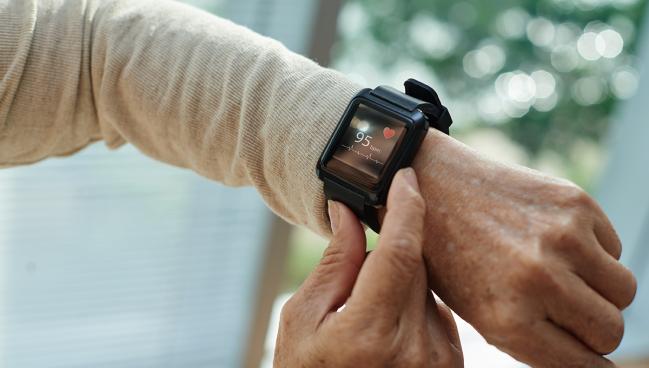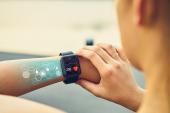Wearable Tech Increasingly Discussed by Primary Care Patients, Doctors
By 2019, records mentioned wearables for about 1% of patients, a “dramatic increase from just a few years prior,” researcher says.

Within the span of a few years, wearable devices have become a wider topic of discussion during patients’ visits to their primary care doctors, according to a new study that analyzed data on nearly half a million people in New England. By 2019, just under 1% of patients had office notes that mentioned wearable tech like step trackers and portable heart rate monitors.
“This represents a dramatic increase from just a few years prior,” senior author Steven A. Lubitz, MD, MPH (Massachusetts General Hospital, Boston), told TCTMD, adding, “These findings are consistent with expectations given the swift uptake of wearable technology by consumers.” If anything, their analysis likely underestimates how widely these technologies are being used, he noted in an email, since the topic doesn’t come up during every medical encounter.
Lubitz said they were motivated to do the research because of the many open questions in this space.
“Over the last decade, we have seen the development and swift uptake of consumer technology capable of measuring physiologic information of potential clinical relevance, such as physical activity, heart rate, and electrocardiograms. However, the importance of these consumer technologies in routine clinical care is unclear,” he explained.
Led by Mostafa A. Al-Alusi, MD (Massachusetts General Hospital), the study was published recently as a research letter in Circulation: Cardiovascular Quality and Outcomes.
Fitbit the Biggest Contributor
The researchers analyzed more than 21 million outpatient notes for nearly 492,192 primary care patients treated in the Mass General Brigham network between 2005 and 2019. They searched for product names such as AliveCor Kardia, Apple Watch, Fitbit, and Garmin, as well as generic terms like smartwatch, fitness tracker, and step tracker.
Patients had a mean age of 48 years, 61% were women, and 76% were white. About one-third had hypertension, one-quarter had hyperlipidemia, 3.2% had atrial fibrillation/flutter, and 7.5% had other arrhythmias.
In 2005, just one note (0.0002% of notes and 0.0006% of patients) mentioned wearable use. By 2019, the proportion rose to 0.14% of notes and 0.89% of patients. The most frequently cited product—and the one most responsible for the rise—was Fitbit, used by 74.1% of patients with devices.
Factors associated with wearable devices in patient records included female sex, higher income, obesity, atrial fibrillation/flutter, hyperlipidemia, other arrhythmias, and hypertension. On the flip side, wearables were less often mentioned in the notes for nonwhite patients, older individuals, and those with heart failure, a pacemaker/implantable cardioverter-defibrillator, peripheral artery disease, or a history of stroke/TIA.
These conversations started in a variety of ways, Lubitz noted. “In some cases, clinicians are initiating discussion about consumer technology by recommending it to their patients for the purposes of measuring activity, heart rate, assessing for irregular heart rhythms, and measuring ECG signals, among other things. In other cases, patients are initiating discussion by presenting findings from consumer technology to their providers.”
He predicted that, as additional studies validate the accuracy of the device technology and algorithms in detecting clinically relevant signals, “clinicians will find value in integrating data from the sensors into their practices.”
On the patient side, tracking health in and of itself may provide motivation, said Lubitz. “Software may further promote healthy behaviors.”
He cited several questions yet to be answered. First, it’s unclear how use of wearable devices impacts clinical outcomes and how clinicians should integrate data from these products into their practice. Moreover, the specific ways in which clinicians should “discuss, counsel, and perhaps recommend consumer devices to patients” haven’t been pinned down, Lubitz continued.
And finally, he said, there are the big picture questions to be tackled by future research: “Do wearable devices drive appropriate or inappropriate healthcare utilization? Does consumer health technology contribute to disparities in care, and can it be used to mitigate existing disparities?”
Caitlin E. Cox is News Editor of TCTMD and Associate Director, Editorial Content at the Cardiovascular Research Foundation. She produces the…
Read Full BioSources
Al-Alusi MA, Khurshid S, Wang X, et al. Trends in consumer wearable devices with cardiac sensors in a primary care cohort. Circ Cardiovasc Qual Outcomes. 2022;15:e008833.
Disclosures
- Al-Alusi reports no relevant conflicts of interest.
- Lubitz receives sponsored research support from Bristol Myers Squibb/Pfizer, Bayer AG, Boehringer Ingelheim, Fitbit, IBM Health, Medtronic, and Premier, Inc, and has consulted for Bristol Myers Squibb/Pfizer, Bayer AG, Blackstone Life Sciences, and Invitae.





Comments